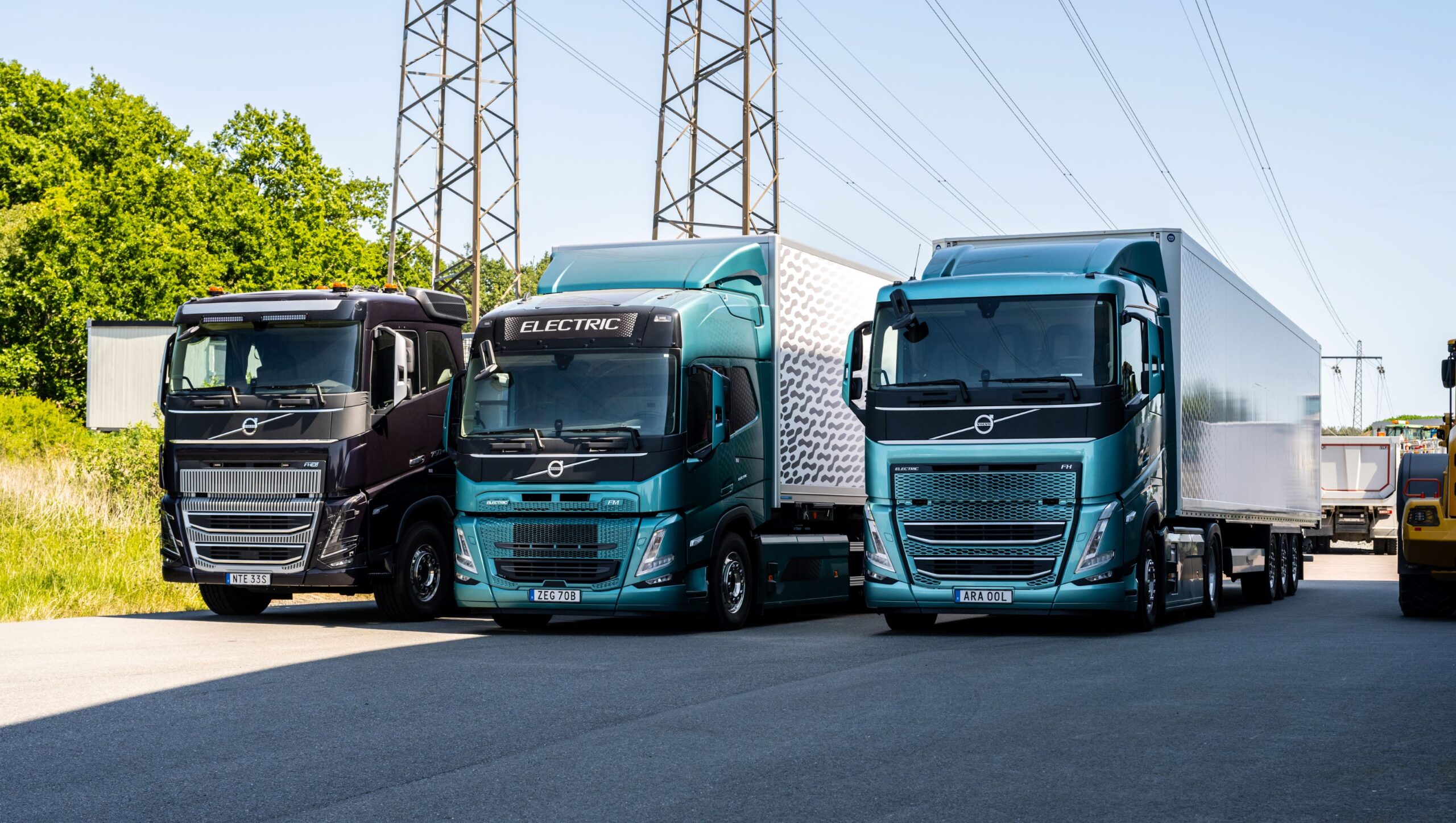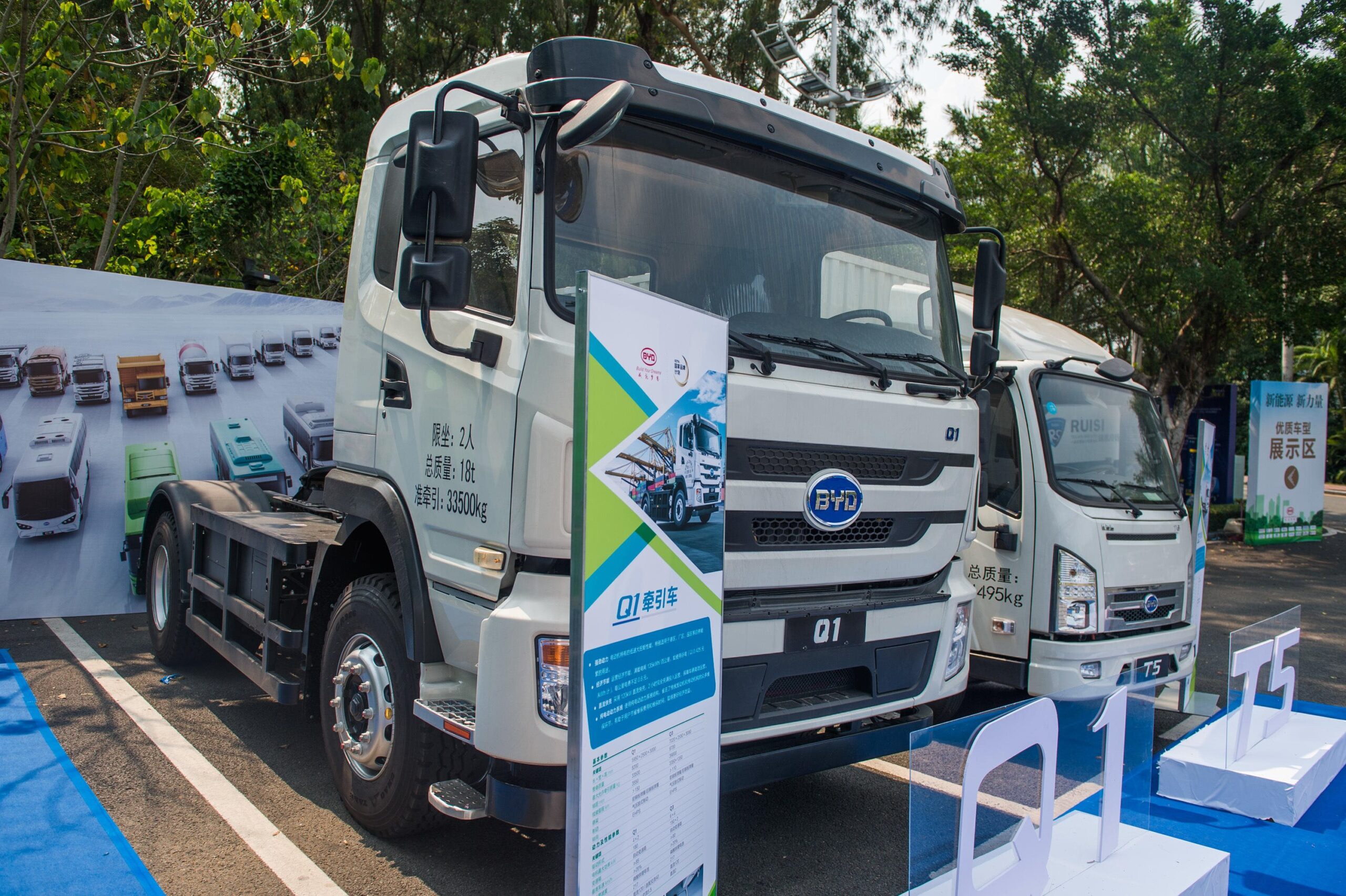
Getting more zero-emission trucks on the road is an important transportation shift that is needed to reduce air pollution, protect public health and curb climate-harming emissions. But transforming the entire trucking industry is a challenging feat that will require the establishment of government policies with ambitious targets.
Some jurisdictions have already begun. For example, new EU legislation requires that by 2040, heavy-duty vehicles reduce carbon emissions by 90% compared to 2019 levels. California’s Advanced Clean Fleets regulation mandates all heavy-duty drayage trucks — which transport large containers or bulk goods to and from seaports, railyards and warehouses — be net zero by 2035.
However, zero-emission trucks — which include those powered by electric batteries and fuel cells — are expensive, with high upfront purchase costs and total costs of ownership making wider adoption difficult. There are also additional technological challenges, including the inability to travel long daily distances without needing to recharge, limited coverage of charging facilities and the weight of heavy batteries reducing the amount of goods that can be carried.
Further, the trucking industry in many parts of the world is dominated by small and midsized businesses that are struggling to switch to zero-emission trucks due to lack of capital and limited access to finance.
Addressing demand-side challenges, particularly for more cost-conscious and less technology-savvy businesses, is critical to promoting the adoption of more zero-emission trucks.
5 Lessons from China’s Efforts To Scale Zero-emission Trucks
China’s Guangdong Province — particularly, the cities of Shenzhen and Foshan — has been successfully leading China’s zero-emission truck adoption for years. In 2023, sales of these trucks were over 28,000 — the largest among all Chinese provinces — as a result of comprehensive government policies.
A recent WRI study on the economic feasibility of zero-emission trucks found that the cities of Shenzhen and Foshan accounted for 60% of the province’s zero-emission light-duty truck sales and 67% of zero-emission heavy-duty truck sales in 2023. The study also sheds light on five lessons that China and other countries should use to promote wider adoption of zero-emission trucks:
1) Accelerate Adoption of Zero-emission Trucks by Choosing Cost-effective Use Cases
Trucks have many vehicle models and operate in many kinds of situations, spanning from light-duty trucks (1.5-4.495 tons) operating in cities for urban delivery, to large tractor trailers (42 to 49 tons) operating between cities for regional delivery. Depending on its purpose, there could be different kinds of adoption opportunities. Identifying the best use case that has near-term potential to start is critical.
WRI’s study reveals that in 2022, Guangdong’s battery-electric light-duty trucks in urban delivery and tractor trailers operating within seaports had not only met most operational requirements, but also reached total cost of ownership parity with diesel counterparts. However, other types of zero-emission trucks, such as tractor trailers and straight trucks used for regional delivery, still have too many challenges to make for an efficient transition. These include the inability to travel long distances without needing to recharge, having to carry less goods because the truck’s batteries are too heavy, as well as high total cost of ownership barriers.
Assuming zero-emission trucks can meet the distance requirements for all use cases, WRI’s study demonstrated that by 2025, even without any policy incentives, the adoption of battery-electric tractor trailers in port drayage are more likely to take off in Guangdong. By contrast, zero-emission trucks used for regional delivery are not expected to be adopted right away because their total cost of ownership parity relative to diesel trucks won’t be reached until 2028 or 2030. Currently, diesel trucks are more energy-efficient than zero-emission trucks for highway driving. And for regional delivery, fuel-cell electric trucks are more cost-competitive than those with electric batteries, if cheap green hydrogen is available.

2) Pay Attention to Energy Prices for Cost-Competitiveness
Finding cost-effective solutions to encouraging more zero-emission truck purchases depends heavily on energy prices. If diesel prices were to drop, then zero-emission trucks won’t achieve parity with diesel trucks until a much later date.
Therefore, with lower diesel prices, removal of diesel subsidies, increased taxes on diesel prices or incentives on electricity and hydrogen will be needed to maintain the cost-competitiveness of zero-emission trucks.
Further, WRI’s study shows that in less time-sensitive situations, choosing battery-electric trucks with smaller batteries (which are much less expensive than trucks with large batteries), ensuring that charging facilities are sufficiently available and adjusting operation schedules to allow a battery electric truck more than one charge a day, are important in reducing its total cost of ownership.
Taking port drayage for example, if fleet owners choose a battery-electric tractor trailer with a smaller battery pack of a 200-kilometer (124-mile) range, the truck could perform a vehicle kilometers traveled (VKT) rate of 200-400 kilometers (124-249 miles) daily with two to three charges per day. Compared with a battery-electric tractor trailer with a large battery pack of a 400-kilometer (249-mile) range, the battery-electric truck with the 200-kilometer range is cheaper to buy and would reach total cost ownership parity with diesel trucks several years earlier. This also makes tractor trailers in drayage the most promising use cases to be electrified now.
In this case, it is crucial to have:
- Broad availability of fast charging facilities, parking spaces and grid capacities to ensure chargers are available.
- Operation schedules that allow for sufficient charging time windows. For example, time charging with trucks’ waiting times at the port, during loading or unloading, or during break times of drivers.
- Sufficiently long daily VKTs, which translate to fewer cost gaps between battery-electric trucks and diesel trucks.
3) Leasing Trucks Can Ease Upfront Purchase Prices
To ease costly upfront expenses of zero-emission trucks for fleet owners — particularly for small fleet owners — leasing has become a relatively common business model for zero-emission light-duty trucks, where fleet owners only pay a monthly lease or per kilometer payment to use the vehicle.
However, risks are high for leasing zero-emission heavy-duty trucks, due to high upfront purchase costs, volatile transportation demands and limited creditworthiness of small freight carriers. Therefore, derisking measures are needed to scale the leasing models for heavy-duty trucks, such as unlocking green finance (through reduced interested rates and extended repayment terms) for zero-emission truck procurement; and providing tax benefits, flexible depreciation or first loss guarantees for zero-emission truck leasing companies.
Although total cost of ownership parity with diesel trucks will be reached in most use cases by 2030, tremendous gaps in purchase costs remain. For example, by 2030, the purchase price of zero-emission trucks are still 53% to 322% higher than those of diesel trucks in all use cases.
The wide price gaps between zero-emission trucks and diesel trucks could be attributed to the low vehicle prices of diesel trucks in many countries. For example, in China, a 42-ton tractor with 200-kilometer port drayage costs nearly twice the purchase price of its diesel counterpart.

4) Comprehensive Policies Are Most Effective for Quick Adoption
While there is no silver bullet for solving all the challenges zero-emission trucks face, comprehensive policy incentives are more effective at making zero-emission trucks cost effective at an earlier date than single measures.
WRI’s study found that by combining several policies, battery-electric trucks can reach total cost of ownership parity with their diesel counterparts in most cases by model-year 2025. Fuel-cell electric trucks could reach parity before model-year 2028.
These policies include:
- Purchase Subsidies: Considering the high costs of fuel-cell electric trucks, purchase subsidies can help defray the costs.
- Tax Exemptions: Diesel trucks are subject to a 10% percent purchase tax and an ownership tax in China. WRI’s study shows that tax exemptions are essential to bridging the cost gaps for all use cases.
- Energy Incentives: WRI’s study shows that waiving demand charges for zero-emission truck charging, offering subsidies on energy prices, and offering subsidies on the construction and operation of charging or refueling infrastructure are instrumental to reduce the costs of zero-emission trucks in many use cases.
- Road Access Privileges: To curb traffic congestion, trucks face stringent access restrictions in many cities. However, cities should consider relaxing restrictions for zero-emission trucks while maintaining the restrictions for diesel trucks.
- Reduction of Expressway Road Tolls: To incentivize the adoption, some regions in China have offered reduced toll rates for zero-emission trucks. WRI’s study reveals that the policy is more influential for heavy-duty trucks that drive long distances along expressways.
- Increase of Maximum Authorized Weights: Heavy electric battery weight means zero-emission trucks might have to carry less goods. Providing zero-emission trucks with an additional 2-ton allowance compared to diesel trucks could help with heavy goods transportation.
- Interest Rate Reductions: Loan interest rates vary among fleet operators and their creditworthiness, with small freight carriers facing higher annual interest rates. WRI’s study shows if the interest rate drops, zero-emission trucks will become cost-competitive in short mileage use cases.
However, apart from the proposed comprehensive policies, fleet owners would still need to take multiple factors into consideration. For example, shippers with ambitious climate goals would require the use of zero-emission trucks when sourcing transport services. Fleet owners who transport products of high profit margins such as alcohol and medicine would be more willing to adopt zero-emission trucks, as they see higher revenues.
5) Data Is Necessary To Make Policy and Business Decisions
As costs and technology of zero-emission trucks are expected to evolve over the next five to 10 years, it will be important to ensure those making policy and business investment decisions have access to data for both zero-emission trucks and existing diesel fleets.
Policymakers, for example, will need information on how real-world energy-efficiency of trucks would greatly affect zero-emission trucks’ total cost of ownership to determine when different use cases will become competitive.
For automakers, statistics on the daily mileage of existing truck fleets are critical to designing battery electric trucks, including the sizes of battery capacities, to meet operational requirements.
Also, for charging point operators, the truck traffic flows and stop locations of existing truck fleets are necessary to inform investments on charging points.
Therefore, it is important for governments to gather the operational statistics of existing diesel truck fleets and zero-emission trucks that can be shared among key stakeholders.
This article originally appeared on WRI’s Insights.
Lulu Xue is Urban Mobility Manager for the Sustainable Cities program at WRI China.
Ke Chen is Transport Research Analyst for the Sustainable Cities program at WRI China.








